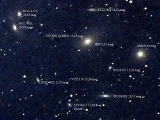
Virgo Cluster
Overview
Galaxy cluster
A galaxy cluster is a compact cluster of galaxies. Basic difference between a galaxy group and a galaxy cluster is that there are many more galaxies in a cluster than in a group. Also, galaxies in a cluster are more compact and have higher velocity dispersion. One of the key features of cluster is...
whose center is 53.8 ± 0.3
1 E22 m
To help compare different orders of magnitude, this page lists distances starting at 10 Zm .Distances shorter than 10 Zm* 24 Zm — 2.5 million light years — Distance to the Andromeda Galaxy...
Mly (16.5 ± 0.1 Mpc
Parsec
The parsec is a unit of length used in astronomy. It is about 3.26 light-years, or just under 31 trillion kilometres ....
)
away in the constellation
Constellation
In modern astronomy, a constellation is an internationally defined area of the celestial sphere. These areas are grouped around asterisms, patterns formed by prominent stars within apparent proximity to one another on Earth's night sky....
Virgo
Virgo (constellation)
Virgo is one of the constellations of the zodiac. Its name is Latin for virgin, and its symbol is . Lying between Leo to the west and Libra to the east, it is the second largest constellation in the sky...
. Comprising approximately 1300 (and possibly up to 2000) member galaxies, the cluster forms the heart of the larger Local Supercluster, of which the Local Group
Local Group
The Local Group is the group of galaxies that includes Earth's galaxy, the Milky Way. The group comprises more than 30 galaxies , with its gravitational center located somewhere between the Milky Way and the Andromeda Galaxy...
is an outlying member. It is estimated that its mass is 1.2 M☉
Solar mass
The solar mass , , is a standard unit of mass in astronomy, used to indicate the masses of other stars and galaxies...
out to 8 degrees of the cluster's center or a radius of about 2.2 Mpc.
Many of the brighter galaxies in this cluster, including the giant elliptical galaxy
Elliptical galaxy
An elliptical galaxy is a galaxy having an approximately ellipsoidal shape and a smooth, nearly featureless brightness profile. They range in shape from nearly spherical to highly flat and in size from hundreds of millions to over one trillion stars...
Messier 87
Messier 87
Messier 87 is a supergiant elliptical galaxy. It was discovered in 1781 by the French astronomer Charles Messier, who cataloged it as a nebulous feature. The second brightest galaxy within the northern Virgo Cluster, it is located about 16.4 million parsecs from Earth...
, were discovered in the late 1770s and early 1780s and subsequently included in Charles Messier
Charles Messier
Charles Messier was a French astronomer most notable for publishing an astronomical catalogue consisting of deep sky objects such as nebulae and star clusters that came to be known as the 110 "Messier objects"...
's catalogue of non-cometary fuzzy objects.
Unanswered Questions

